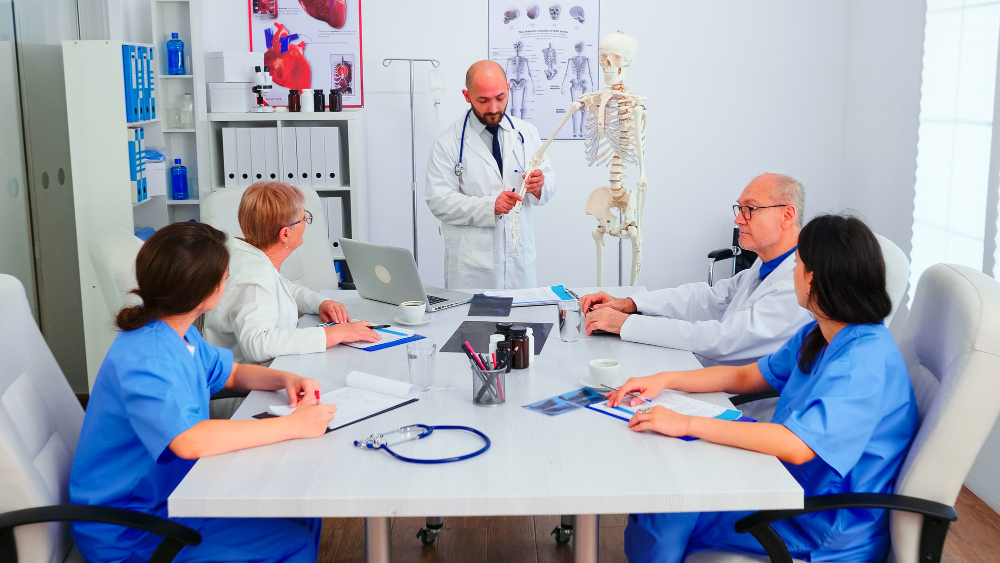골형성단백질 번역(한국어 원본)재조합 골형성단백질2형은 우수한 골형성능으로 척추유합술이나 골절수술 등에 사용되고 있으나 진행생물에서 배양하는 것 보다 원핵생물에서 배양하는 것이 대량으로 생산할 수 있는 장점이 있다. 이에, 저자들은 대장균에서 발현된 재조합 골형성단백질2형을 가토후외방유합술을 이용해 여러 용량으로 이식한 후 유합능을 비교하고자 한다. 뉴질랜드 백색 수컷 가토 76마리(3-3.5kg)에 대해 양측 후외방 유합술을 시행하였고, 담체로는 다공성 하이드록시아파타이트를 사용하였다. 한쪽 하이드록시아파타이트 담체에 각각 0ug, 10ug, 50ug, 200ug, 500ug, 1000ug, 2000ug의 골형성단백질2형을 주입하여 양극 횡돌기 사이에 삽입하고, 3주군, 6주군으로 나누어 3주, 6주에 단순방사선검사, 도수촉진검사, 3차원 마이크로 전산화단층촬영, 조직학검사를 시행하였다. 총 67마리에 대해 최종 분석하였고, 3주군에서 0ug군의 유합률이 0%인데 비해 10ug군은 33.3%, 50ug군과 200ug군은 83.3%, 500ug 이상은 100%의 유합률을 보여 대조군에 비해 50ug 이상 처리한 군은 통계적으로 유의하게 높았다. 6주군에서 0ug군은 25%, 10ug군은 75%, 50ug 이상은 100%의 유합률을 보여 대조군에 비해 10ug 이상 처리한 군은 모두 통계적으로 유의하게 높았다. 비탈석회화 조직학 검사상 하이드록시아파타이트 대조군은 3주, 6주에 세라믹 기공 내에 골과 인접한 기공 위주로 연골성 조직이 차 있었으나 골조직 형성은 미미하였고, 10ug군 부터는 3주부터 기공 내에 골조직을 확인할 수 있었고 50, 200, 500ug군은 더 뚜렷하였다. 6주군에서도 골형성단백질2형을 처리한 군에서 기공 및 주변에 골조직 형성이 더 왕성하였다. 저자들이 이전에 가토 후외방유합술로 하이드록시아파타이트 삽입 후 12주 경과시 유합률이 70-80%여서 골유합이 이루어지기 이전인 3주와 6주에 유합상태를 평가하였는데, 골형성단백질2형을 주입할 경우 하이드록시아파타이트 단독 삽입군에 비해 골형성이 조기에, 더 많이 이루어졌고, 특히 50ug 이상 처리할 경우 6주 경과시에도 100%의 유합률을 보여 하이드록시아파타이트 단독 삽입시보다 유의하게 높은 유합률과 조기 유합률을 얻을 수 있었고, 조직학 결과에서도 동일한 소견을 관찰할 수 있었다. 결국, 50ug 이상의 골형성단백질2형을 하이드록시아파타이트 담체로 이식할 경우 가토 횡돌기에서는 조기에 완전한 골유합을 얻을 수 있어 대장균 발현 재조합골형성단백질2형의 골형성능과 하이드록시아파타이트가 골형성단백질2형의 담체로서 적절하다는 결과를 확인하였다. 하이드록시아파타이트를 담체로한 대장균 발현 재조합 골형성단백질2형이 척추 유합술에서 골대체재로 사용 가능하다는 것을 확인하였다. |
골형성단백질 번역(영어 번역본)Recombinant Human Bone Morphogenic Protein-2 (rhBMP-2) is excellent in bone formation, thus is useful in spinal fusion and orthopedic surgeries. Mass cultivation of rhBMP-2 is more appropriate in prokaryotes than in eukaryotes. Therefore, the authors attempt to compare the fusion rates induced by transplantation of different dosages of E.coli-expressed rhBMP-2 using posterolateral fusion of rabbits.
Bilateral posterolateral fusion was conducted on 76 New Zealand white male rabbits (3-3.5kg), using porous Hydroxyapatite as the carrier. 0ug, 10ug, 50ug, 200ug, 500ug, 1000ug, and 2000ug of rhBMP-2 were injected in one Hydroxyapatite carrier, which was then implanted into the bilateral transverse process. The subjects were divided into the 3-week and 6-week groups to be evaluated with Radiography, Manual Palpation and Bending Test, 3D micro-CT and tissue examinations in 3 weeks and 6 weeks, respectively.
Final comprehensive analysis of 67 rabbits showed that the fusion rates of 3-week group were 0% for 0ug, 33.3% for 10ug, 83.3% for 50ug and 200ug, and 100% for 500ug or more of rhBMP-2. The improvement of 50ug or more groups from the control group was all statistically significant. The fusion rates of 6-week group were 25% for 0ug, 75% for 10ug, and 100% for 50ug or above; the difference from the control group was statistically significant for all groups with 10ug or more.
Tissue decalcification test of the control group in 3 and 6 weeks displayed insignificant rate of bone tissue formation despite the presence of cartilaginous tissues in the ceramic pores adjacent to the bone. 10ug group showed some bone tissues within the pores from 3 weeks, which could be more vividly observed in 50, 200 and 500ug groups. 6-week groups also presented finer bone tissue formation activity within and around pores in rhBMP-2 experimental groups.
Authors have previously reported fusion rates reaching 70-80% after 12 weeks of hydroxyapatite implantation using posterolateral fusion of rabbits. This study therefore sets the evaluation periods as 3 and 6 hs, well before the previously observed bone fusion. The authors could confirm that injecting rhBMP-2 displayed an earlier and more active bone formation than implanting hydroxyapatite alone. Especially the experimental groups with 50ug or more rhBMP-2 reached 100% fusion rate after 6 weeks, which was significantly higher and earlier fusion rates than the single implantation of Hydroxyapatite. The tissue examination agreed with this result.
In conclusion, injection of 50ug or more rhBMP-2 into the Hydroxyapatite carrier induced the earlier bone fusion completion in intertransverse processes of rabbits, which verified the excellent bone forming ability of E.Coli-derived rhBMP-2 and the suitability of Hydroxyapatite as the carrier of rhBMP-2. This confirms that the E.Coli-expressed rhBMP-2 with Hydroxyapatite carrier can be used as the bone graft substitute in spinal fusion. |
